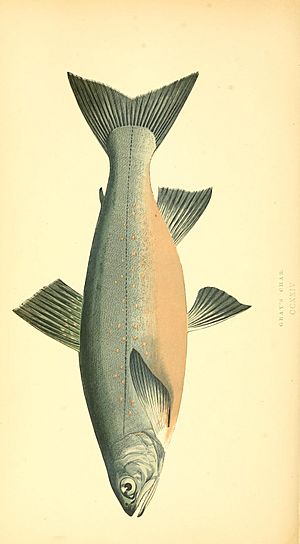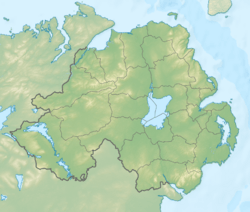Gray's char facts for kids
Quick facts for kids Gray's char |
|
|---|---|
 |
|
| Conservation status | |
| Scientific classification | |
| Genus: |
Salvelinus
|
| Species: |
grayi
|
| Synonyms | |
|
Salmo grayi (Günther, 1862) |
|
Salvelinus grayi, also known as Gray's char or Lough Melvin char, is a special type of fish. It belongs to the char family, which are related to salmon and trout. This fish lives only in Lough Melvin, a lake in Ireland. Sadly, there are very few Gray's char left. Experts say it is a critically endangered animal. This means it is at a very high risk of disappearing forever.
Contents
What is Gray's Char?
How it Got its Name
The scientist Albert Günther first described this fish. He named it after his friend and fellow scientist, John Edward Gray. That's why it's called "Gray's char."
The word "char" might come from an old Irish word, ceara. This word means "blood red." It probably refers to the fish's reddish belly. In Welsh, a similar fish is called torgoch, which also means "red belly."
What Does it Look Like?
Gray's char usually grows to be about 10 to 12 inches (25 to 30 centimeters) long. It weighs around 8 ounces (227 grams).
Compared to other char fish, Gray's char has a deeper body. It is also flatter from side to side. It has a shorter tail section and bigger scales. You can tell it apart from other char by its whitish spots. These spots are found on its upper sides and on its tail and back fins.
Life Cycle and Habits
Gray's char are benthopelagic fish. This means they live near the bottom of the lake. They are usually found 30 to 100 feet (10 to 30 meters) deep.
They only come to shallower waters during their spawning season. Gray's char eat tiny water fleas. These fleas are small crustaceans. The fish lay their eggs in November. They choose shallow, rocky areas of the lake for spawning.
Why is Gray's Char Endangered?
The number of Gray's char in Lough Melvin has dropped a lot. In 1975, scientists counted 33 fish. By 1986, there were 42. But in 2001, only 12 fish were found. This big drop is why it is now critically endangered.
Two main reasons are blamed for this decline. One is the introduction of other fish. Fish like Common rudd and roach were brought into the lake. These new fish might compete with the char for food. They might also eat the char's eggs or young.
Another big problem is eutrophication. This happens when too many nutrients, like phosphorus, get into the lake. Phosphorus often comes from farms around the lake. Char fish are very sensitive to these changes. Too much phosphorus can make the water unhealthy for them.
In 2003, there was a plan to move some char to another lake. But no fish could be found, even after a long search. Scientists also haven't seen the char spawning in their usual spots. This shows how serious the situation is for Gray's char.
 In Spanish: Salvelinus grayi para niños
In Spanish: Salvelinus grayi para niños



